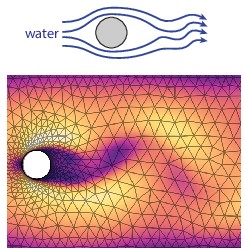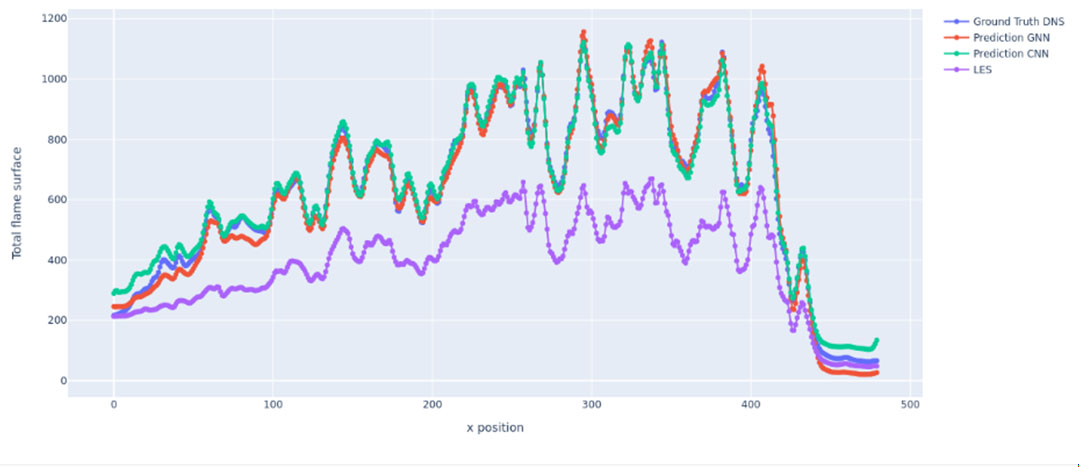Empowering numerical simulations on irregular meshes with graph neural networks
From the precision of industrial design in manufacturing to the accuracy of weather forecasts, numerical simulations are essential. However, they increasingly demand computational power that’s both invaluable and costly. Still, the benefits of simulating physical systems numerically are undeniable. It reduces energy consumption and increases tool and device efficiency.
An example: The development of carbon-free hydrogen combustion engines requires precise predictions of temperature profiles in combustion reactions. Here, accurate simulations are key to optimizing performance and sustainability.
A GraphNet (Graph Neural Network, GNN) is a neural network architecture that directly handles graphs as data. This blog post explains how we on Eviden’s AI4SIM team use GraphNets to replace parts of the computational workflow of a traditional finite element solver. This will help to accelerate combustion numerical simulations, offering a new strategy to speed up the industry’s development cycles — and enhance the efficiency of combustion engines.
Following the work of Lapeyre[1], we propose to filter a fully resolved direct numerical simulation (DNS) down to a coarser mesh, onto which a numerical simulation would be more computationally tractable. We filter down each physical field  to a low-dimensional and weighted field
to a low-dimensional and weighted field  .
.
Once in the low-dimensional space, the well-established Large Eddy Simulation (LES) provides the dynamics of the filtered progress variable,  , a scalar field keeping track of the global extent of reaction of the local mixture of the chemical processes[2]. The dynamics can be written as[3]:
, a scalar field keeping track of the global extent of reaction of the local mixture of the chemical processes[2]. The dynamics can be written as[3]:
 The whole problem then boils down to solving this equation for
The whole problem then boils down to solving this equation for  in the reduced-order space where
in the reduced-order space where  is the velocity field carrying the quantities throughout the combustion chamber, and
is the velocity field carrying the quantities throughout the combustion chamber, and  can be interpreted as a generalized flame surface density (FSD).
can be interpreted as a generalized flame surface density (FSD).
According to the flamelet hypothesis, most of the combustion is carried by surface flames, hence precisely estimating  is essential to numerically solving the problem in the reduced-order space. The issue is that filtering down the
is essential to numerically solving the problem in the reduced-order space. The issue is that filtering down the  progress variable fails to capture the amount of flame wrinkling, contributing to most of the flame surface. Therefore, we must resort to modeling the value of the flame surface density
progress variable fails to capture the amount of flame wrinkling, contributing to most of the flame surface. Therefore, we must resort to modeling the value of the flame surface density  to achieve consistent combustion simulations in the reduced-order space.
to achieve consistent combustion simulations in the reduced-order space.
Various analytical models have been proposed to tackle this problem, but none is fully convincing. Lapeyre et al. proposes to use convolutional neural networks (CNNs) to learn the relation between  and
and  , relying on the efficient U-Net deep learning architecture[4]. However, the convolutional architecture requires the fields to be sampled on a regular cartesian mesh, which is impracticable for most industrial cases. Indeed, most meshing tools used in the industry produce highly irregular meshes, with adaptive cell sizes. As a makeshift solution to this issue, one can interpolate the irregular mesh onto a grid, but this trick turns out impracticable on industrial use cases, as it leads to a proliferation of useless computations.
, relying on the efficient U-Net deep learning architecture[4]. However, the convolutional architecture requires the fields to be sampled on a regular cartesian mesh, which is impracticable for most industrial cases. Indeed, most meshing tools used in the industry produce highly irregular meshes, with adaptive cell sizes. As a makeshift solution to this issue, one can interpolate the irregular mesh onto a grid, but this trick turns out impracticable on industrial use cases, as it leads to a proliferation of useless computations.
To address this issue in a principled way, we propose to encode surrogate physics directly into GraphNets. Therefore, the simulation mesh can be directly fed into the neural model for prediction, regardless of its topology. The following picture is an example of irregularly meshing the physical space around a cylinder to simulate the flow[5]. It is worth noting that the mesh is finer close to the domain boundaries, i.e., around the obstructing cylinder and close to the walls, where the flow is more complex.

Image Source: Eviden
This strategy allowed us to demonstrate the efficiency of graph-based neural architectures for surrogating part of physical processes. The following picture shows the fully resolved combustion simulation (DNS, on the left) compared to an analytical model (LES, in the middle) that significantly underestimates the flame surface.

Image Source: Eviden
On the other hand, our GraphNet (GNN, in the middle below) allows for a much more precise estimation of the flame density.

Finally, plotting the total flame surface on the burner’s axis shows how accurately the neural networks-based models (see below, GNN in red, CNN in green) can capture this part of the physics. These pre-trained models can reach 48% improved accuracy compared to a state-of-the-art LES simulation coupled with an analytical model.

Image Source: Eviden
These simulations not only showcase the ingenuity of marrying advanced neural network architectures with complex physical processes but also herald a significant leap toward more efficient and accurate simulations. GraphNets are an elegant and principled solution to enrich numerical simulation pipelines with AI, allowing for more rapid prototyping engines.
Join Léo Nicoletti at the 35th Parallel CFD International Conference for more in-depth conversations.
References and sources
[1] C.J. Lapeyre, A. Misdariis, N. Cazard, D. Veynante, T. Poinsot, Training convolutional neural networks to estimate turbulent sub-grid scale reaction rates, 2018.
[2] Charles David Pierce, Progress-variable approach for Large-Eddy Simulation of Turbulent Combustion, 2001
[3] R. Knikker, D. Veynante, C. Meneveau, A dynamic flame surface density model for large eddy simulation of turbulent premixed combustion, Phys. Fluids16 (2004) L91–L94.
[4] O. Ronneberger, P. Fischer, T. Brox, U-Net: Convolutional Networks for Biomedical Image Segmentation, 2015.
[5] T. Pfaff, M. Fortunato, A. Sanchez-Gonzalez, P. Battaglia, Learning Mesh-Based Simulation with Graph Networks, 2020.

